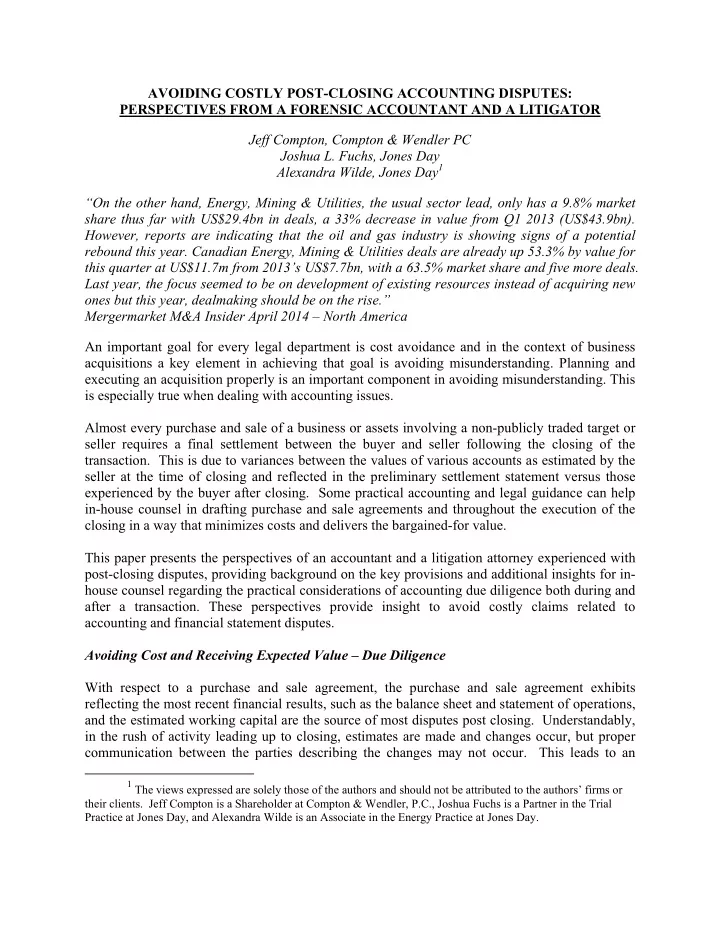

AVOIDING COSTLY POST-CLOSING ACCOUNTING DISPUTES: PERSPECTIVES FROM A FORENSIC ACCOUNTANT AND A LITIGATOR Jeff Compton, Compton & Wendler PC Joshua L. Fuchs, Jones Day Alexandra Wilde, Jones Day 1 “On the other hand, Energy, Mining & Utilities, the usual sector lead, only has a 9.8% market share thus far with US$29.4bn in deals, a 33% decrease in value from Q1 2013 (US$43.9bn). However, reports are indicating that the oil and gas industry is showing signs of a potential rebound this year. Canadian Energy, Mining & Utilities deals are already up 53.3% by value for this quarter at US$11.7m from 2013’s US$7.7bn, with a 63.5% market share and five more deals. Last year, the focus seemed to be on development of existing resources instead of acquiring new ones but this year, dealmaking should be on the rise.” Mergermarket M&A Insider April 2014 – North America An important goal for every legal department is cost avoidance and in the context of business acquisitions a key element in achieving that goal is avoiding misunderstanding. Planning and executing an acquisition properly is an important component in avoiding misunderstanding. This is especially true when dealing with accounting issues. Almost every purchase and sale of a business or assets involving a non-publicly traded target or seller requires a final settlement between the buyer and seller following the closing of the transaction. This is due to variances between the values of various accounts as estimated by the seller at the time of closing and reflected in the preliminary settlement statement versus those experienced by the buyer after closing. Some practical accounting and legal guidance can help in-house counsel in drafting purchase and sale agreements and throughout the execution of the closing in a way that minimizes costs and delivers the bargained-for value. This paper presents the perspectives of an accountant and a litigation attorney experienced with post-closing disputes, providing background on the key provisions and additional insights for in- house counsel regarding the practical considerations of accounting due diligence both during and after a transaction. These perspectives provide insight to avoid costly claims related to accounting and financial statement disputes. Avoiding Cost and Receiving Expected Value – Due Diligence With respect to a purchase and sale agreement, the purchase and sale agreement exhibits reflecting the most recent financial results, such as the balance sheet and statement of operations, and the estimated working capital are the source of most disputes post closing. Understandably, in the rush of activity leading up to closing, estimates are made and changes occur, but proper communication between the parties describing the changes may not occur. This leads to an 1 The views expressed are solely those of the authors and should not be attributed to the authors’ firms or their clients. Jeff Compton is a Shareholder at Compton & Wendler, P.C., Joshua Fuchs is a Partner in the Trial Practice at Jones Day, and Alexandra Wilde is an Associate in the Energy Practice at Jones Day.
expectation gap after closing when the results do not match estimates provided to the buyer, particularly when the basis for such estimates were not known to the buyer. Consequently, internal and external resources are needed to reconcile expectations with concomitant costs. Our discussion here goes beyond the typical adjustments made to working capital, which occur strictly between the parties with little or no controversy. Instead, we offer suggestions to reduce the cost of disputed adjustments requiring arbitration, which can require outside litigation counsel. Moreover, we offer practical advice to help avoid claims for breaches of representations and warranties, which can lead to far more serious and costly disputes, especially those rising to the use of the “F” word – Fraud. Before discussing specific examples, potential buyers and sellers should consider the nature of Generally Accepted Accounting Principles (“GAAP”). Most of us know to focus on the noun – the word “principles.” GAAP always remain subject to interpretation. Equally correct answers can exist, based upon different reasoning applied to the same principles and facts. Most experienced sellers limit the potential disagreement over the application of GAAP by specifying that the seller’s GAAP, as applied by the seller’s auditors in the seller’s historical financial statements, will control. If the seller’s auditors performed an audit immediately after the closing, there would be less potential for misunderstanding, but that is not the reality. In practice, the buyer will take exception to the seller’s treatment of transactions during the period since the last audit and through closing. Accordingly, the buyer’s corporate accounting staff, at times supplemented by outside accountants, should perform careful due diligence on all of the seller’s accounts before and after the closing to understand just how the seller’s accountants interpreted and applied GAAP. When considering GAAP, one must understand the fundamental use of estimates. Transactions are recorded not when the cash changes hands but when the rights and obligations arise, which in turn necessitates estimates. Estimates can be changed as better information becomes available. More importantly, the method of estimation can change, particularly when the buyer imposes their accounting methods on the newly acquired seller. Although changes to estimates create potential adjustments to the purchase price, changes from one GAAP method to another generally should not create purchase price adjustments. For example, the seller may have estimated its bad debts using a historical percentage, but then revise such estimation method to an equally acceptable direct write off method where specific customers are written off. Such change should not generally create a claim for working capital or purchase price adjustment. Limits exist as to the retroactive adjustment of accounts as better information regarding prior estimates becomes available: “Subsequent events affecting the realization of assets, such as receivables and inventories or the settlement of estimated liabilities, should be recognized in the financial statements when those events represent the culmination of conditions that existed over a relatively long period of time. For example, a loss on an uncollectible trade account receivable as a result of a customer’s 2
Recommend
More recommend